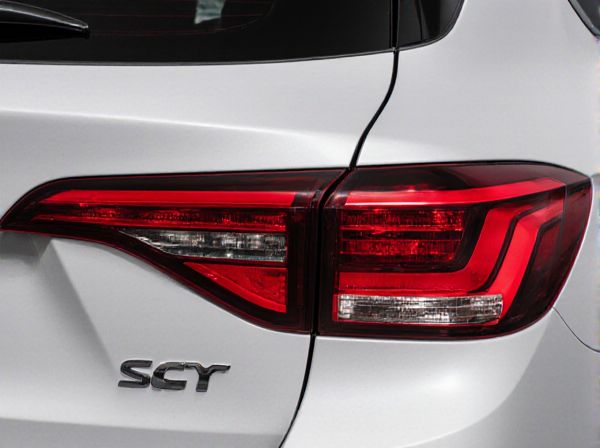
Photo illustration: Module Taillight vs One-piece Taillight
Module taillights offer easier repairs by allowing individual components to be replaced without changing the whole unit, saving time and money. One-piece taillights provide a streamlined design with improved durability and a sleeker appearance but may require full replacement if damaged. Choosing between the two depends on your preference for maintenance convenience versus aesthetic uniformity.
Table of Comparison
| Feature | Module Taillight | One-piece Taillight |
|---|---|---|
| Design | Modular components, customizable | Integrated single unit, fixed design |
| Repair Cost | Lower, replace individual module | Higher, replace entire unit |
| Installation | Complex, multiple connectors | Simple, single connector |
| Durability | Potential weak points at joints | More robust, less failure points |
| Customization | High, easy to upgrade parts | Limited, fixed features |
| Weight | Generally lighter due to separate parts | Heavier due to integrated design |
Introduction: Understanding Taillight Designs
Module taillights feature separate components integrated into a cohesive unit, offering easier repair and customization options. One-piece taillights combine all lighting elements into a single housing, providing a streamlined appearance and enhanced durability against weather conditions. Understanding these taillight designs helps in selecting the right option based on vehicle style and functionality requirements.
What is a Module Taillight?
A module taillight integrates multiple lighting functions such as brake, turn signal, and reverse lights into a single, compact unit with modular components for easy replacement and customization. Unlike one-piece taillights, module taillights offer enhanced flexibility, improved repairability, and often incorporate advanced technologies like LEDs or adaptive lighting. These features contribute to better vehicle safety and streamlined maintenance processes.
Overview of One-piece Taillight Design
One-piece taillight design features an integrated housing that combines brake lights, turn signals, and reverse lights into a single assembly, enhancing aerodynamic efficiency and installation simplicity. This design reduces the number of seals and potential leakage points, improving durability and weather resistance compared to modular systems. Automakers favor one-piece taillights for streamlined manufacturing processes and sleek vehicle aesthetics.
Comparison of Aesthetics and Styling
Module taillights feature segmented lighting elements that create a modern, high-tech appearance suitable for contemporary vehicle designs, emphasizing functionality with distinct light patterns. One-piece taillights offer a seamless, continuous lens that enhances a vehicle's sleekness and cohesive styling, often preferred for classic or minimalist aesthetics. The choice between the two depends on the desired visual impact and overall vehicle design philosophy, with module taillights focusing on intricate detailing and one-piece taillights prioritizing smooth surface integration.
Installation and Replacement Differences
Module taillights streamline installation by integrating multiple lighting functions into a single unit, reducing wiring complexity and minimizing installation time. One-piece taillights, while simpler in design, often require separate bulb replacements, making maintenance more frequent but easier and less costly per instance. The modular design typically demands complete unit replacement upon failure, whereas one-piece taillights allow for partial repairs, affecting long-term maintenance strategies.
Performance and Light Output
Module taillights offer enhanced performance by allowing individual LED components to be replaced or upgraded, ensuring consistent light output over time and reducing maintenance costs. One-piece taillights integrate all lighting elements into a single unit, providing uniform light distribution but potentially facing complete replacement if one element fails, which can impact cost efficiency. In terms of light output, module taillights typically deliver more precise illumination with adjustable intensity for improved visibility and safety, while one-piece designs emphasize seamless appearance and durability.
Durability and Maintenance Considerations
Module taillights feature individual LED units that enhance durability by isolating damage to specific modules, simplifying repairs and reducing maintenance costs. One-piece taillights, constructed as a single integrated unit, often require full replacement upon failure or damage, leading to higher maintenance expenses. Their sealed design may limit accessibility, whereas module taillights allow targeted servicing, promoting longer lifespan and reduced downtime.
Cost Analysis: Module vs One-piece
Module taillights typically cost more upfront due to their complex design integrating multiple lighting functions into separate, replaceable units, while one-piece taillights offer a lower initial price thanks to their simpler, unified construction. Maintenance expenses for module taillights can be lower over time since individual modules can be replaced without changing the entire assembly, contrasting with one-piece taillights that often require complete replacement for any malfunction. Considering total cost of ownership, module taillights may provide better value in long-term use despite higher initial costs, driven by reduced repair needs and enhanced customization potential.
Safety Features and Innovations
Module taillights incorporate multiple LED units in separate compartments, enhancing visibility and reducing bulb failure risk with faster illumination times compared to traditional bulbs. One-piece taillights offer a streamlined design with integrated LEDs that improve durability and resistance to moisture, contributing to consistent light performance and enhanced safety. Both designs often include adaptive brake light patterns and smart sensors that alert drivers to sudden stops, increasing reaction time and road safety.
Choosing the Right Taillight for Your Vehicle
Choosing the right taillight for your vehicle depends on factors like installation ease, vehicle compatibility, and maintenance. Module taillights offer customizable LED segments for enhanced visibility and repair convenience, while one-piece taillights provide a streamlined design with fewer installation steps. Assess your vehicle model, driving conditions, and aesthetic preferences to determine which taillight type ensures optimal safety and performance.
 caratoz.com
caratoz.com